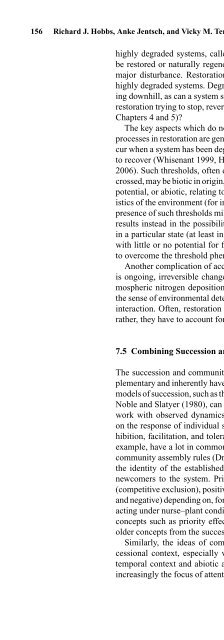Linking Restoration and Ecological Succession (Springer ... - Inecol
Linking Restoration and Ecological Succession (Springer ... - Inecol
Linking Restoration and Ecological Succession (Springer ... - Inecol
You also want an ePaper? Increase the reach of your titles
YUMPU automatically turns print PDFs into web optimized ePapers that Google loves.
156 Richard J. Hobbs, Anke Jentsch, <strong>and</strong> Vicky M. Temperton<br />
highly degraded systems, called in older parlance “dis-climax” systems, can<br />
be restored or naturally regenerate back to a state similar to that prior to the<br />
major disturbance. <strong>Restoration</strong> can learn from how succession proceeds on<br />
highly degraded systems. Degraded, naturally retrogressive seres can keep going<br />
downhill, as can a system subjected to an anthropogenic disturbance. So, is<br />
restoration trying to stop, reverse, <strong>and</strong>/or completely restart the succession (see<br />
Chapters 4 <strong>and</strong> 5)?<br />
The key aspects which do not allow for simple acceleration of successional<br />
processes in restoration are generally related to threshold phenomena which occur<br />
when a system has been degraded beyond its resilience or inherent capacity<br />
to recover (Whisenant 1999, Hobbs <strong>and</strong> Harris 2001, Harris <strong>and</strong> van Diggelen<br />
2006). Such thresholds, often difficult to identify <strong>and</strong> quantify before they are<br />
crossed, may be biotic in origin, relating to species loss, gain, or altered dispersal<br />
potential, or abiotic, relating to changes in the physical or chemical characteristics<br />
of the environment (for instance, altered soil structure or chemistry). The<br />
presence of such thresholds militates against a simple successional process <strong>and</strong><br />
results instead in the possibility of alternative states with the system “stuck”<br />
in a particular state (at least in the time frames within which humans operate)<br />
with little or no potential for further development without active intervention<br />
to overcome the threshold phenomenon in evidence.<br />
Another complication of accelerated succession as a simple restoration goal<br />
is ongoing, irreversible change in the environment, such as accumulating atmospheric<br />
nitrogen deposition. Such change may create novel l<strong>and</strong>scapes in<br />
the sense of environmental determinants for species assembly <strong>and</strong> successional<br />
interaction. Often, restoration goals cannot rely on historical reference seres;<br />
rather, they have to account for novel environments.<br />
7.5 Combining <strong>Succession</strong> <strong>and</strong> Assembly<br />
The succession <strong>and</strong> community assembly approaches can be viewed as complementary<br />
<strong>and</strong> inherently have a lot in common. Clearly, the more mechanistic<br />
models of succession, such as those described by Connell <strong>and</strong> Slatyer (1977) <strong>and</strong><br />
Noble <strong>and</strong> Slatyer (1980), can be interpreted in a community assembly framework<br />
with observed dynamics being the result of impacts of various events<br />
on the response of individual species <strong>and</strong> interactions among species. The inhibition,<br />
facilitation, <strong>and</strong> tolerance models of Connell <strong>and</strong> Slatyer (1977), for<br />
example, have a lot in common with so-called “priority effects” in the field of<br />
community assembly rules (Drake 1991, Belyea <strong>and</strong> Lancaster 1999) whereby<br />
the identity of the established species within an ecosystem has an effect on<br />
newcomers to the system. Priority effects in assembly can also be negative<br />
(competitive exclusion), positive (nurse–plant effects), or neutral (both positive<br />
<strong>and</strong> negative) depending on, for example, the phenological phase of plants interacting<br />
under nurse–plant conditions (e.g., Flores-Martínez et al. 1994). Hence,<br />
concepts such as priority effects could simply be viewed as the renaming of<br />
older concepts from the succession literature.<br />
Similarly, the ideas of community assembly can be interpreted in a successional<br />
context, especially where community assembly is considered in a<br />
temporal context <strong>and</strong> abiotic as well as biotic factors are considered. This is<br />
increasingly the focus of attention in community assembly studies (see Weiher

















